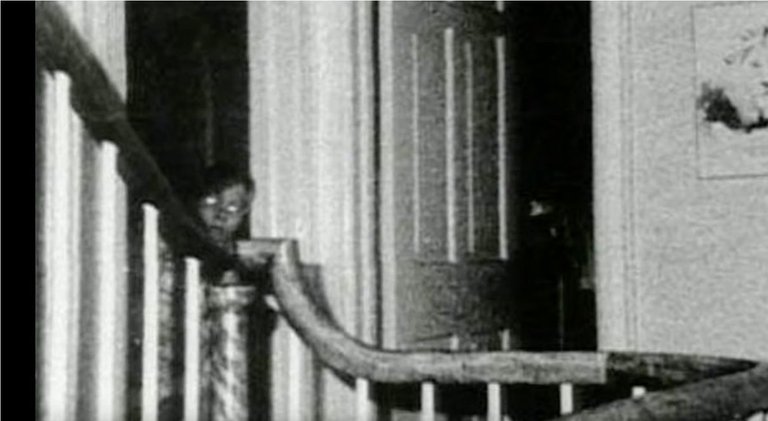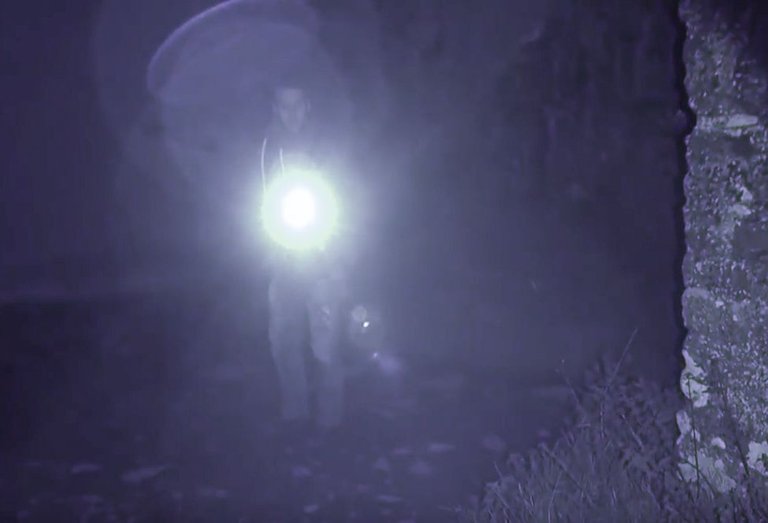For most people, ghosts are creepy creatures, living in ancient European castles, foggy moors, on cemeteries or in old mansions. But this is not true. In fact, ghosts are everywhere. Dark dungeons, hidden catacombs or ancient ruins covered with a veil of sorrow and pain are not essential to find them. The suspicion or recognition that ghosts exist is simply a resurrection of one of mankind´s oldest and most basic beliefs: There is a life after death.

A ghost child. This image was taken by Ed Warren during the investigation of the Amityville case in 1974.
A ghost is the energy, soul or personality of anyone who has died and has somehow gotten stuck between this plane of existence and the next. Ghosts can be perceived by the living in a number of ways: through visual manifestation (apparition), sound (voices), smell (frangrances and odors), touch - and sometimes they can just be sensed.
The difference between a ghost and a haunting
How the ghost manifests itself is unknown. There seems to be a close association between aspects of the dead person´s life and the manifestation as a ghost. These include a sudden or unusual death, strong ties to loved ones or a particular place, unfinished business, strong emotions, or a desire for revenge.
Ghosts can interact with the living, perform purposeful activities and respond to ongoing changes in the environment. That is the difference between a ghost and a haunting. Professional ghost hunters make a clear difference between these two kinds of paranormal phenomena. Unlike ghosts, hauntings do not display intelligent action. They do not interact with the living. Hauntings may be environmental imprints - recordings of something that happened at a certain place. They tend to be associated with a specific place or object, not with a particular person. If you see a haunting, it feels like a video loop that plays the same scene over and over. Ghosts instead are intelligent creatures.

Just me. During a paranormal investigation of the Hellfire Club in Ireland.
They may talk to the living, predict an accident or disaster, give advice, or express their love, anger, or disappointment. Ghosts may try to complete tasks or projects they failed to finish before death. Some of them try to move furniture and room decorations to suit their preferences. Some ghosts appear solid as living people because they do not know they are dead. Others manifest as partial apparitions because they are confused about the transition from life to death. Noise and moving objects are often attributed to a poltergeist. Most parapsychologists believe that living people, not the dead, cause these kind of apparitions. Someone under great emotional stress releases psychic energy that creates subtle or spectacular changes in the environment. Poltergeist events can be stopped through locating and removing the emotionally unstable living person.
Ghosts interact with our environment in different ways. It may have something to do with talents or skills they possessed in life, personal objectives, or level of frustration in getting our attention. Some ghosts create odors or sounds, associated with their habits, like cigar smoke or singing.
Sounds, including voice messages, may be detected with an audio recorder. Ghost hunters have recorded screams, warnings, greetings and much more.Ghosts like to knock, turn doorknobs, scatter matchsticks and move keys. Some ghosts manipulate light switches and TV remotes. A poltergeist have enough power to throw objects and move heavy furniture. It is very frightening and dangerous to meet a poltergeist. Dangerous objects such as knives or hammers may hit people. Ghosts cannot tolerance disturbances within the place they haunt. Objects placed in the ghost´s path may be pushed aside. Ghosts can also create ice cold breezes and unexplained gusts of wind. Temperature changes sometimes occur with a feeling the atmosphere has thickened, as if the room was suddenly filled with invisible people. Ghosts may create images on cameras and video recorders, such as luminous fog, streaks of light, or partial outlines of body parts.
Most times, ghosts remain in a particular place because they are emotionally attached to a building, a room, or special surroundings that affected them during their lives, or played an important role in their death. It is widely believed that sudden transition from the physical world to the Hereafter confuse the ghost. He or she remains in familiar or emotionally stabilizing surroundings to ease the strain. Ghosts may linger in a house, factory or restaurant waiting for a loved one or any hints that might help them deal with their new level of existence. Some ghosts wander through forests, on bridges, or alongside particular sections of a street. Others await enemies seeking revenge, or wait for a friend. As you can see, ghosts are nearly humans. They share the same feelings and habits like us.
@resteemator is a new bot casting votes for its followers. Follow @resteemator and vote this comment to increase your chance to be voted in the future!
Hello. As a new Steemian, I've only just read some of your posts. I enjoyed several, so I am following you now.
This posting, however, contains numerous assertions for which I wonder how you could possibly have evidence. Examples:
"In fact, ghosts are everywhere." ¶ "There seems to be a close association between aspects of the dead person's life and the manifestation as a ghost." ¶ "Ghosts can interact with the living, perform purposeful activities and respond to ongoing changes in the environment." ¶ "Ghosts may try to complete tasks or projects they failed to finish before death." ¶ "Some ghosts appear solid as living people because they do not know they are dead. Others manifest as partial apparitions because they are confused about the transition from life to death." ¶ "Some ghosts create odors or sounds, associated with their habits, like cigar smoke or singing." ¶ "Most times, ghosts remain in a particular place because they are emotionally attached to a building, a room, or special surroundings that affected them during their lives, or played an important role in their death."
How did you reach these conclusions? Even if you have evidence that some ghostly encounters represent a genuine phenomenon, how can you claim to know what ghosts do or don't know, and whether they are confused, and about what, if so?
Guessing the mental states — even of living persons — can occasionally be difficult. Surely the task is that much harder when the mental state you seek to identify belongs to an entity whose existence is nebulous, on a plane whose reality is in dispute.
If I seem too dismissive, I apologize. I don't claim to own any maps of reality's borders. What's more, I have seen an apparition or three myself, though even at the time I doubted they were ghosts, exactly. And I'm aware that folklore has worth, to some extent.
Nevertheless, I like to stay within lasso range of actual evidence, just so we can work out how deep the quicksand is where we're standing.
Hello @custone,
Thanks for this detailed comment. Our team has not only seen ghosts in old, dilapidated buildings. We also experienced the phenomenon in supermodern, futuristic buildings. That's why I claim that spirits can be everywhere. For earthbound spirits, we assume that they retain many of their human qualities that they had during their lifetime.
Of course, to deduce the state of mind, I have to start from the human qualities. If it comes to a ghost apparition, first the history of the place where the appearance occurred must be checked. Let´s take the Amityville case as an example. Ed Warren knew that children in this house had died. He probably also knew where in the house these children had preferred to play. So he put his camera in the place where they are most likely to appear as ghosts. In this way, he managed to shoot the picture you see in the post.
The confusion arises from the nature of the appearance. If we assume that a spirit can think clearly, it is possible for it to make the decision to manifest itself. In this case, the manifestation is clear and complete. If the ghost is not aware of its state, it may not even plan to manifest itself or make that decision half-heartedly. Accordingly, the quality of the manifestation is worse.
But there is another theory here: To manifest, the spirit needs energy. For example, it can draw heat energy from the air. For this reason it is getting colder while the spirit manifests in a room. If there is not enough heat energy available, the spirit can not fully manifest. In this case, of course, the state of mind does not matter, that is pure physics.
I hope I could clarify most of your questions.
Thanks for your thoughtful reply. I hope you will keep sharing more about your team's personal experiences in further postings, as well as the evidence and reasoning behind any conclusions you draw.
Be sure I will do :-)